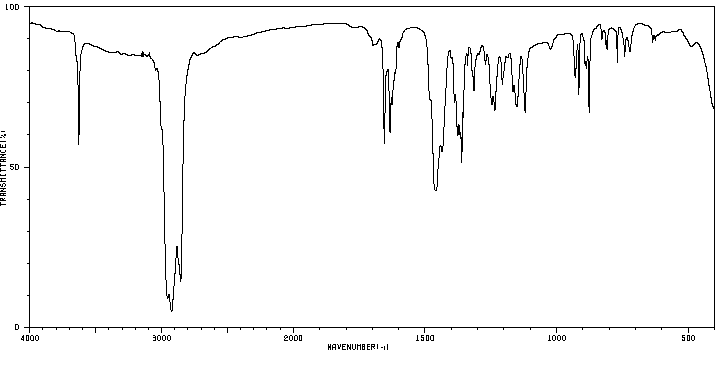2,6-di-tert-butyl-4-(3,5-di-tert-butyl-4-hydroxyphenyl)-4-methyl-2,5-cyclohexadiene-1-one | 14387-13-4
中文名称
——
中文别名
——
英文名称
2,6-di-tert-butyl-4-(3,5-di-tert-butyl-4-hydroxyphenyl)-4-methyl-2,5-cyclohexadiene-1-one
英文别名
2,6-Di-tert-butyl-4-(3,5-di-tert-butyl-4-hydroxyphenyl)-4-methyl-2,5-cyclohexadien-1-one;3,3',5,5'-tetra-tert-butyl-4'-hydroxy-1-methyl-[1,1'-biphenyl]-4(1H)-one;2,6-Di-tert.-butyl-4-methyl-4-<3,5-di-tert.-butyl-4-hydroxyphenyl>-2,5-cyclohexadien-1-on;1-Methyl-1-(3',5'-di-tert-butyl-4'-hydroxy-phenyl)-3,5-di-tert-butyl-4-benzochinon;2,6-ditert-butyl-4-(3,5-ditert-butyl-4-hydroxyphenyl)-4-methylcyclohexa-2,5-dien-1-one
CAS
14387-13-4
化学式
C29H44O2
mdl
——
分子量
424.667
InChiKey
PKUGNNBDQOWNCU-UHFFFAOYSA-N
BEILSTEIN
——
EINECS
——
-
物化性质
-
计算性质
-
ADMET
-
安全信息
-
SDS
-
制备方法与用途
-
上下游信息
-
文献信息
-
表征谱图
-
同类化合物
-
相关功能分类
-
相关结构分类
物化性质
-
熔点:153-154 °C
-
沸点:465.9±45.0 °C(Predicted)
-
密度:0.982±0.06 g/cm3(Predicted)
计算性质
-
辛醇/水分配系数(LogP):9.4
-
重原子数:31
-
可旋转键数:5
-
环数:2.0
-
sp3杂化的碳原子比例:0.62
-
拓扑面积:37.3
-
氢给体数:1
-
氢受体数:2
反应信息
-
作为产物:描述:2,6-二叔丁基-4-甲基苯酚 在 二乙胺 作用下, 以 乙腈 为溶剂, 反应 16.0h, 生成 2,6-di-tert-butyl-4-(3,5-di-tert-butyl-4-hydroxyphenyl)-4-methyl-2,5-cyclohexadiene-1-one参考文献:名称:可见光照射下 TiO2 表面复合物中酚类的碱辅助活化摘要:由TiO 2和酚类形成的表面电荷转移复合物在可见光光催化中显示出巨大的潜力。然而,背电子转移限制了电荷转移效率和表面络合物中酚类的活化。在此,我们揭示了通过引入碱来有效活化表面复合物中的酚类。同源偶联反应和丁基化羟基甲苯捕获的实验都清楚地证明了从各种木质素衍生的底物中产生酚自由基。碱的加入引起了表面配合物的蓝移吸收,同时增加了可见光诱导的从衬底到TiO 2的电子激发。振动光谱表明酚盐和 TiO 2之间的相互作用更强高于中性苯酚。这种碱基触发策略可能有助于通过表面复合物对酚进行有用的转化或降解。DOI:10.1016/j.jphotochem.2022.114005
文献信息
-
Construction of Vicinal Quaternary Carbons via Cu-catalyzed Dearomative Radical Addition作者:Naoki Tsuchiya、Takashi NishikataDOI:10.1246/cl.190247日期:2019.7.5In this paper, we confirmed the dearomative addition of tertiary alkyl radicals onto BHT derivatives to form highly congested vicinal quaternary carbons to produce tert-alkylated styrenes in the pr...
-
Some unusual oxidation products of 2,6-di-tert-butyl-4-methylphenol作者:Ben M. Benjamin、Vernon F. Raaen、Edward W. Hagaman、Lloyd L. BrownDOI:10.1021/jo00409a011日期:1978.7
-
The reaction of the 2,6-di-tert-butyl-4-methylphenoxy radical with phenols作者:Kanji OmuraDOI:10.1021/jo00003a006日期:1991.2Dimer 3 dissociates in solution to give the phenoxy radical 4. When solid 3 is dissolved in a solution of phenol 11a, radical 4 dehydrogenates the phenol to afford phenol 5 and phenoxy radical 12. Radical 12 couples with more 4 to afford principally bis(cyclohexadienone) 16a and a minor amount of the dimeric bis(cyclohexadienone) 13. The preferential formation of 16a over 13 is explained as the result of a solvent-cage reaction. Compounds 13 and 16a are isomerized in the presence of silica gel or triethylamine to 4,4'-dihydroxybiphenyl 14 and phenolic dienone 17a, respectively. Compound 13 is relatively stable in hexane at 30-degrees-C, while 16a slowly dissociates under these conditions to afford parent radicals 4 and 12. If 11a is present, radical 4 either recombines with 12 or dehydrogenates the phenol. Two radicals of 12 generated by the dissociation of 16a and the subsequent dehydrogenation of 11a couple to give 13. Therefore, dissolving 3 in hexane containing excess 11a and keeping the resulting solution at 30-degrees-C results in the preferential formation of 13. Dissolving 3 in triethylamine containing phenols 11 or 21 similarly affords dienones 17 or 23. The yields of these dienones increase with increasing electron-donating capability of the substituent on the phenol ring.
-
Oxidation of phenols with iodine in alkaline methanol作者:Kanji OmuraDOI:10.1021/jo00191a002日期:1984.8
-
Reinvestigation of the reaction of 2,6-di-tert-butylbenzoquinone methide and 2,6-di-tert-butylphenol作者:Kanji OmuraDOI:10.1021/jo00027a053日期:1992.1The reaction of quinone methide 1 and phenol 2 in equimolar amounts was investigated in pentane at 30-degrees-C. Products were isolated by means of column chromatography on SiO2. There was a marked difference in product distribution between the reactions in the presence and absence of added Et3N. Dienones 3 and 10 were obtained only from the former reaction, while formation of 1,2-bis(4-hydroxyphenyl)ethane 18 and 4,4'-dihydroxybiphenyl 20 was overwhelming in the latter reaction. Other products from both reactions were relatively small quantities of 4,4'-stilbenequinone 17, 4,4'-diphenoquinone 21, and bis(4-hydroxyphenyl)methane 24, but dienone 4 was not obtained. Compounds 20 and 24 obtained from the latter reaction were formed by isomerization of dienones 19 and 23, respectively, during the chromatography. The reaction is initiated by dimerization of 1 to generate biradical 11. Subsequent processes involving hydrogenation-dehydrogenation, coupling-dissociation, and dienone-phenol rearrangement account for the formation or the lack of formation of the products. The difference in product distribution is ascribed to capability of Et3N to catalyze the isomerization. Quinone methide 1 also adds to 2 to give 23. The decay of 1 in the presence of both 2 and phenol 6 gave dienone 8 additionally. The formation of 24 and 4 was facilitated by conducting the reaction of 1 and 2 in DMSO. Dehydrogenation of 10 and 3 with PbO2 afforded spirodienones 27 and 28, respectively. Compounds 27 and 28 were unstable, and their decay in solution was investigated in the presence or absence of added 2. The results show that the decay is initiated by homolytic scission of the C-C bond connecting the dienone rings in the cyclopentane (in 27) and cyclohexane (in 28) rings. Compound 28 is novel in that it bears two kinds of such C-C bonds. Reversibility of the dimerization of 1 is suggested.
表征谱图
-
氢谱1HNMR
-
质谱MS
-
碳谱13CNMR
-
红外IR
-
拉曼Raman
-
峰位数据
-
峰位匹配
-
表征信息
同类化合物
(5β,6α,8α,10α,13α)-6-羟基-15-氧代黄-9(11),16-二烯-18-油酸
(3S,3aR,8aR)-3,8a-二羟基-5-异丙基-3,8-二甲基-2,3,3a,4,5,8a-六氢-1H-天青-6-酮
(2Z)-2-(羟甲基)丁-2-烯酸乙酯
(2S,4aR,6aR,7R,9S,10aS,10bR)-甲基9-(苯甲酰氧基)-2-(呋喃-3-基)-十二烷基-6a,10b-二甲基-4,10-dioxo-1H-苯并[f]异亚甲基-7-羧酸盐
(1aR,4E,7aS,8R,10aS,10bS)-8-[((二甲基氨基)甲基]-2,3,6,7,7a,8,10a,10b-八氢-1a,5-二甲基-氧杂壬酸[9,10]环癸[1,2-b]呋喃-9(1aH)-酮
(+)顺式,反式-脱落酸-d6
龙舌兰皂苷乙酯
龙脑香醇酮
龙脑烯醛
龙脑7-O-[Β-D-呋喃芹菜糖基-(1→6)]-Β-D-吡喃葡萄糖苷
龙牙楤木皂甙VII
龙吉甙元
齿孔醇
齐墩果醛
齐墩果酸苄酯
齐墩果酸甲酯
齐墩果酸溴乙酯
齐墩果酸二甲胺基乙酯
齐墩果酸乙酯
齐墩果酸3-O-alpha-L-吡喃鼠李糖基(1-3)-beta-D-吡喃木糖基(1-3)-alpha-L-吡喃鼠李糖基(1-2)-alpha-L-阿拉伯糖吡喃糖苷
齐墩果酸 beta-D-葡萄糖酯
齐墩果酸 beta-D-吡喃葡萄糖基酯
齐墩果酸 3-乙酸酯
齐墩果酸 3-O-beta-D-葡吡喃糖基 (1→2)-alpha-L-吡喃阿拉伯糖苷
齐墩果酸
齐墩果-12-烯-3b,6b-二醇
齐墩果-12-烯-3,24-二醇
齐墩果-12-烯-3,21,23-三醇,(3b,4b,21a)-(9CI)
齐墩果-12-烯-3,21,23-三醇,(3b,4b,21a)-(9CI)
齐墩果-12-烯-3,11-二酮
齐墩果-12-烯-2α,3β,28-三醇
齐墩果-12-烯-29-酸,3,22-二羟基-11-羰基-,g-内酯,(3b,20b,22b)-
齐墩果-12-烯-28-酸,3-[(6-脱氧-4-O-b-D-吡喃木糖基-a-L-吡喃鼠李糖基)氧代]-,(3b)-(9CI)
齐墩果-12-烯-28-酸,3,7-二羰基-(9CI)
齐墩果-12-烯-28-酸,3,21,29-三羟基-,g-内酯,(3b,20b,21b)-(9CI)
鼠特灵
鼠尾草酸醌
鼠尾草酸
鼠尾草酚酮
鼠尾草苦内脂
黑蚁素
黑蔓醇酯B
黑蔓醇酯A
黑蔓酮酯D
黑海常春藤皂苷A1
黑檀醇
黑果茜草萜 B
黑五味子酸
黏黴酮
黏帚霉酸







